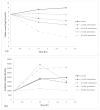Effective Antimicrobial Solutions for Eradicating Multi-Resistant and β-Lactamase-Producing Nosocomial Gram-Negative Pathogens
- PMID: 34827221
- PMCID: PMC8614872
- DOI: 10.3390/antibiotics10111283
Effective Antimicrobial Solutions for Eradicating Multi-Resistant and β-Lactamase-Producing Nosocomial Gram-Negative Pathogens
Abstract
Antimicrobial resistance (AMR) remains one of the greatest public health-perturbing crises of the 21st century, where species have evolved a myriad of defence strategies to resist conventional therapy. The production of extended-spectrum β-lactamase (ESBL), AmpC and carbapenemases in Gram-negative bacteria (GNB) is one such mechanism that currently poses a significant threat to the continuity of first-line and last-line β-lactam agents, where multi-drug-resistant GNB currently warrant a pandemic on their own merit. The World Health Organisation (WHO) has long recognised the need for an improved and coordinated global effort to contain these pathogens, where two factors in particular, international travel and exposure to antimicrobials, play an important role in the emergence and dissemination of antibiotic-resistant genes. Studies described herein assess the resistance patterns of isolated nosocomial pathogens, where levels of resistance were detected using recognised in vitro methods. Additionally, studies conducted extensively investigated alternative biocide (namely peracetic acid, triameen and benzalkonium chloride) and therapeutic options (specifically 1,10-phenanthroline-5,6-dione), where the levels of induced endotoxin from E. coli were also studied for the latter. Antibiotic susceptibility testing revealed there was a significant association between multi-drug resistance and ESBL production, where the WHO critical-priority pathogens, namely E. coli, K. pneumoniae, A. baumannii and P. aeruginosa, exhibited among the greatest levels of multi-drug resistance. Novel compound 1,10-phenanthroline-5,6-dione (phendione) shows promising antimicrobial activity, with MICs determined for all bacterial species, where levels of induced endotoxin varied depending on the concentration used. Tested biocide agents show potential to act as intermediate-level disinfectants in hospital settings, where all tested clinical isolates were susceptible to treatment.
Keywords: 1,10-phenanthroline-5,6-dione; intermediate-level disinfectants; multi-drug resistant; nosocomial pathogens.
Conflict of interest statement
The authors declare there is no conflict of interest relating to this article.
Figures



References
-
- Oliveira J., Reygaert W.C. StatPearls. StatPearls Publishing; Treasure Island, FL, USA: 2021. [(accessed on 19 August 2021)]. Gram Negative Bacteria. [Updated 29 March 2021] Available online: https://www.ncbi.nlm.nih.gov/books/NBK538213/
-
- Sikora A., Zahra F. StatPearls. StatPearls Publishing; Treasure Island, FL, USA: 2021. [(accessed on 19 August 2021)]. Nosocomial Infections. [Updated 10 February 2021] Available online: https://www.ncbi.nlm.nih.gov/books/NBK559312/
-
- Nouri F., Karami P., Zarei O., Kosari F., Alikhani M.Y., Zandkarimi E., Zarandi E.R., Taheri M. Prevalence of Common Nosocomial Infections and Evaluation of Antibiotic Resistance Patterns in Patients with Secondary Infections in Hamadan, Iran. Infect. Drug Resist. 2020;13:2365–2374. doi: 10.2147/IDR.S259252. - DOI - PMC - PubMed
LinkOut - more resources
Full Text Sources

